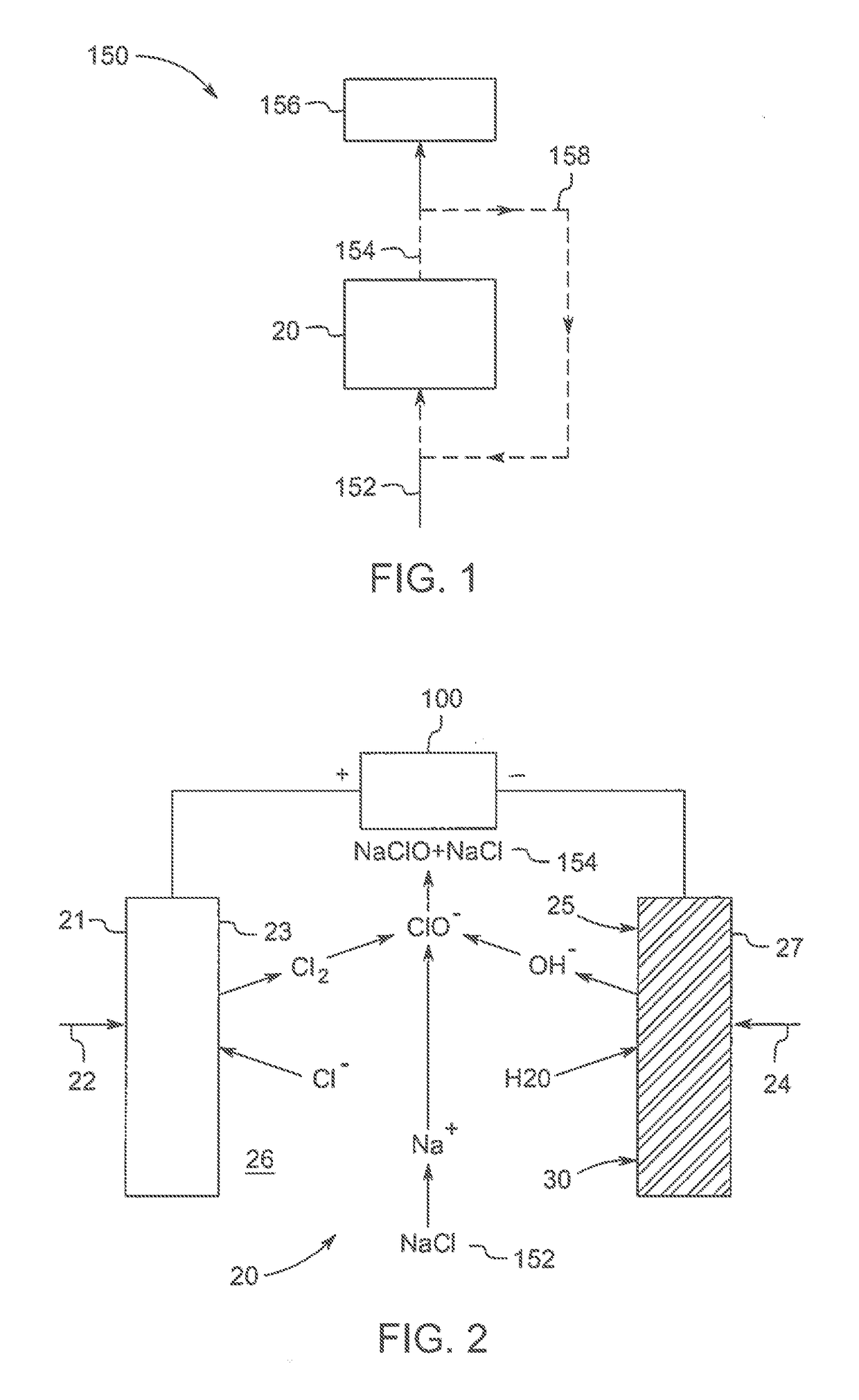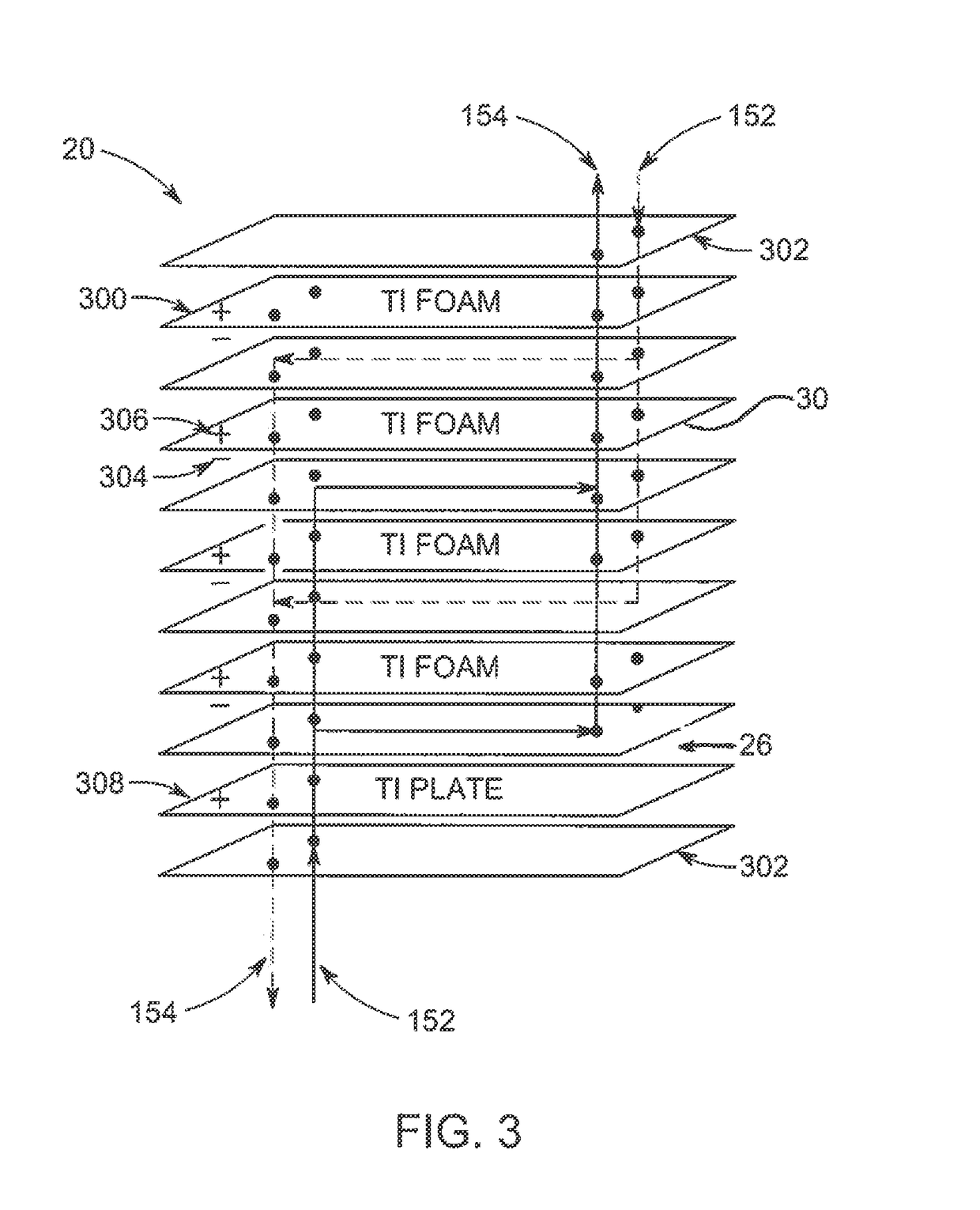Polymeric-metal composite electrode-based electrochemical device for generating oxidants
- Summary
- Abstract
- Description
- Claims
- Application Information
AI Technical Summary
Benefits of technology
Problems solved by technology
Method used
Image
Examples
example 1
Producing the OPBI Polymer
[0069]Monomer A (4,4′-dicarboxydiphenyl ether) and B (3,3′,4,4′-biphenyltetramine) were added at a molar ratio of 1:1 into a three neck flask equipped with a refluxing condenser, a mechanical stirring bar and a nitrogen purging set. A mixture of CF3SO3H and P2O5 at a weight ratio of 10:1 was added into the flask to make a solution in which (A+B) / CF3SO3H×100% was 10 wt %. The solution was then heated to 140° C. under N2 atmosphere for 120-180 minutes. A product (OPBI polymer) was obtained by pouring the reaction product into water, and washing in a Na2CO3 aquatic solution till the pH was neutral. The H NMR data of the OPBI polymer in DMSO were: 7.2-7.4 (brs, 2H), 7.4-8 (br, 3H), 8.2-8.4 (brs, 2H), 13 (brs, 1H).
example 2
Producing the Sulfonated OPBI (SOPBI) Polymer
[0070]The OPBI polymer obtained in example 1 was submerged into 30% fuming sulfuric acid at 80° C. for 120-180 minutes under mechanical stirring to get the sulfonated OPBI (SOPBI) polymer.
[0071]The SOPBI polymer may then be washed in a basic solution comprising an alkali metal to convert at least some of the polymer to its salt form. Suitable basic solutions include, but are not limited to Na2CO3 or NaHCO3 or NaOH. LiOH, and KOH aquatic solutions. The resulting product will have the formula:
wherein M is a hydrogen or an alkali metal, such as Na, Li, or K.
[0072]In the present example, a product (SOPBI polymer) was obtained by pouring the reaction product into water, and washing in a Na2CO3 aqueous solution till the pH was neutral. The H NMR data of the SOPBI polymer in DMSO were: 7-7.2 (brs), 7.2-8 (br), 8.2-8.4 (brs), 8.7-8.8 (brs), 13 (brs). At least a portion of the SOPBI polymer produced is believed to have the formula:
example 3
Coating Electrodes with the OPBI Polymer
[0073]A solution comprising 0.45 g NaOH in 5 mL ethanol was added into a mixture of 2.5 g of the OPBI polymer and 30 mL DMSO, stirred with a magnetic stirring bar at 60° C. until the OPBI polymer was fully dissolved. The resulting solution was filtered through a 0.5 μm PTFE film and the filtrate was degassed under a reduced pressure.
[0074]The filtrate was applied to three different titanium foam electrodes (4 cm×10 cm) as follows. For Electrode A, the titanium foam electrode was immersed in a container with the filtrate to coat the electrode with the filtrate. The electrode was removed from the container and heated at 80° C. for one hour to crosslink the filtrate thereby forming the polymer coating on the electrode. The average pore size for the electrodes was 300 μm.
[0075]For Electrode B, some of the filtrate was cross-linked into a polymer membrane. The polymer membrane was then hot pressed to a titanium foam electrode thereby forming a poly...
PUM
| Property | Measurement | Unit |
|---|---|---|
| Level | aaaaa | aaaaa |
Abstract
Description
Claims
Application Information
 Login to View More
Login to View More - R&D
- Intellectual Property
- Life Sciences
- Materials
- Tech Scout
- Unparalleled Data Quality
- Higher Quality Content
- 60% Fewer Hallucinations
Browse by: Latest US Patents, China's latest patents, Technical Efficacy Thesaurus, Application Domain, Technology Topic, Popular Technical Reports.
© 2025 PatSnap. All rights reserved.Legal|Privacy policy|Modern Slavery Act Transparency Statement|Sitemap|About US| Contact US: help@patsnap.com



